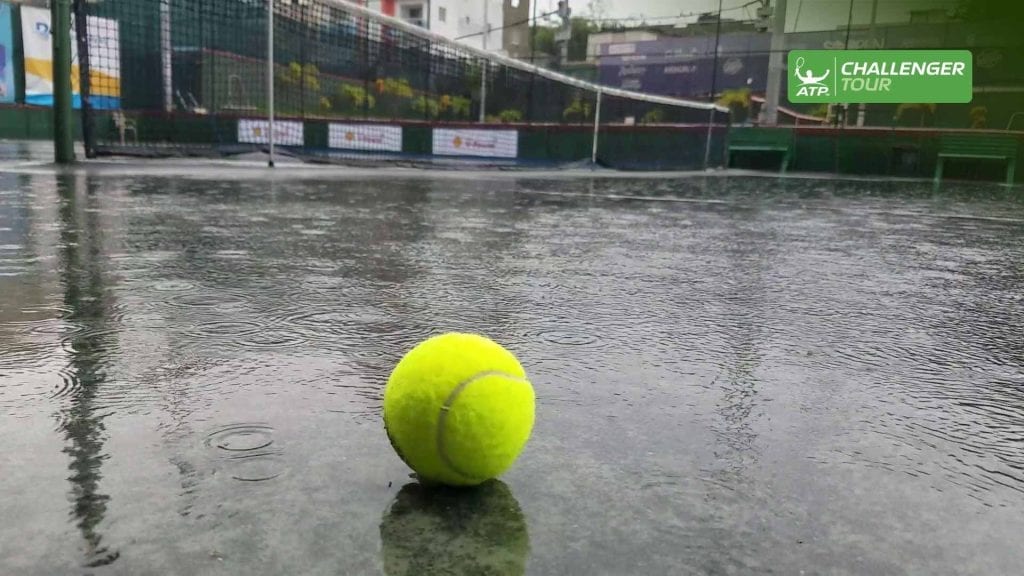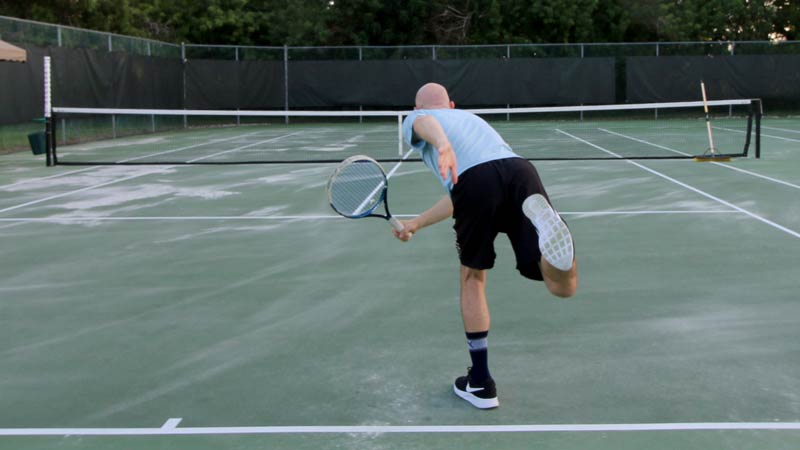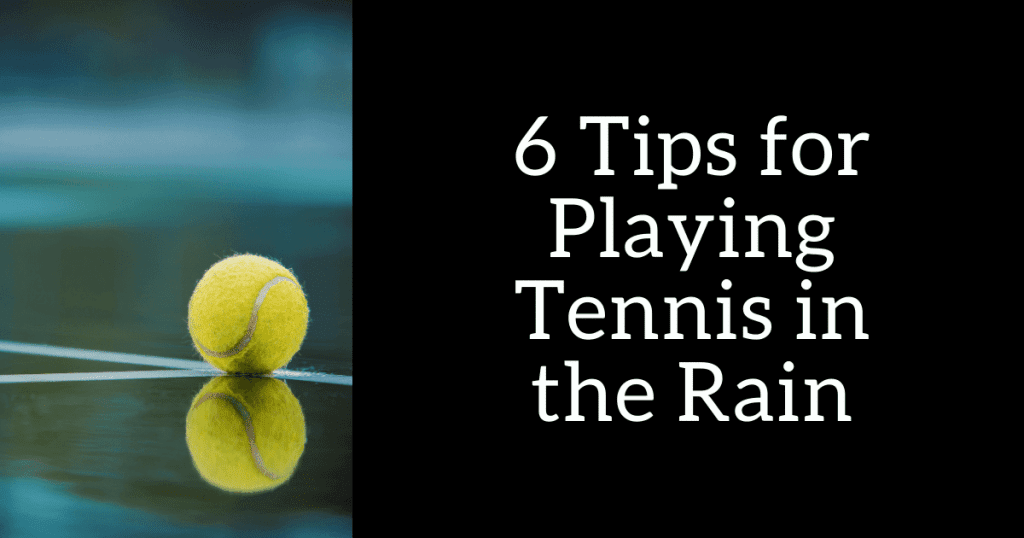Playing tennis in the rain? Tennis and rain – do they mix? One wouldn’t think so.
Has the rain been ruining your game by keeping you off the court?
Contents
Can You Play Tennis in the Rain?
Yes you can. You might sustain an injury, but you CAN play tennis in the rain. Is it recommended – not really…
The surface you’re planning on playing on will need to be considered. That’s a mouthful…
There are increased risks associated with playing on a wet court or in the rain, but if you have good enough footing, you can still play.
Can You Play Tennis on a Wet Court?

If it’s a hard court, I wouldn’t recommend it. You can, but you’re upping the chance of sustaining an injury or having an awful time on the court.
You’re used to playing on a dry court; one that doesn’t have any slippage, dust or variables that get in your way.
If a court is slightly damp, use a squeegee to remove any excess moisture. A semi-slick court is almost more dangerous than an outright wet court.
Most public courts will have a squeegee hanging from the fence. Put it to use.
Nobody can predict how the rain is going to affect your game, but rest assured that it will definitely affect your movement and stability.
Playing tennis on a wet hard court means you’re very likely to slip and fall.
Grass might even be slicker. Playing on a wet grass court is a fairly miserable experience, so if you can avoid it, do it.
Clay is a surface that’s meant to be watered so you can play on it while it’s raining and not worry about it as much. Playing during a downpour isn’t fun and can damage the court. Use your best judgment.
There’s asphalt, grass, clay—you take your pick.
Each court surface has a different level of resistance (and absorption) to rain.
6 Tips for playing in the rain
We’ve developed some tips to help you alter your game and adjust to the rain without having to call it quits for the day.
Apart from these tips, there are also some answers to your burning questions about playing in the rain.
1. Step Up Your Volley Game

You and your opponent are both at a disadvantage, so why not make something good out of it?
You can switch to volleying the ball more rather than staying in long rallies hitting groundstrokes.
If you tend to be a baseline hitter you’ll confuse your opponent by showing him something different, but you’re also making the points shorter so as not to allow much time to get hurt running around on a wet court!
2. Don’t Use a Kick Serve

Kick serves are excellent, but they just don’t have their place on wet courts.
When the court is dry, the ball has more bounce to it which is the magic of a kick serve. A kick serve tends to ‘kick’ up past a comfortable position for returning.
During wet or rainy conditions, the court will basically swallow much of the magical bounce and your serve will end up perfectly in the strike zone of your opponent.
Your opponent will likely start crushing your returns…
If hitting a kick serve is a mainstay of your game, you’ll have to adapt a bit, but it isn’t practical when the weather is against you.
3. Bend Your Knees More

The bounce coming in from your opponent’s ball is dampened, so to speak. We just recommended to not hit a kick serve because the bounce is taken away.
The same thing happens when receiving whether it be a serve or a groundstroke – the ball is going to be much lower.
You won’t be leaping off the ground to smack a forehand over the net.
Shots will come in slower and lower, so you need to position yourself in such a way to capitalize.
Once you bend your knees you’ll lower your total center of gravity and that can take a little getting used to. It’s actually form we’re all taught when we first learn to play.
Go back to the basics and really get down low to the ball.
4. Groundstroke Game Modifications

The ball is coming in lower which means you’re going to have to react differently.
If someone is usually a super power player, you may have a better chance of getting the ball back as their shots will be slowed down quite a bit.
But if you usually don’t have a problem returning their shots, the slower balls will bounce shorter in the court and you’ll actually have less time to react to get to the ball.
If you have slice shots in your arsenal, take them out and use them. Sliced balls naturally don’t rise as much and you’ll likely frustrate your opponent.
5. Beware of Traction Changes

If it’s heavy rain, you’re probably not going to be playing outside. Please DO NOT play in heavy rain. Please.
If it’s moderate or enough that you feel like you can handle it, that’s good, but keep in mind the traction on your tennis shoes is going to suffer a bit.
The traction on your shoes changes a lot depending on their age and surface. Be mindful of what kind of shoes you’re wearing and be careful.
On hard courts you’re likely to end up on your butt or possibly with a knee injury.
On clay/har tru courts you’ll have a lot of excess material in your shoes as the heavy clay will get in all the nooks and crannies of the bottom of your shoes.
Can Tennis Balls Get Wet?

Yes tennis balls can get wet. It isn’t recommended, but they won’t wither away if they get wet.
The outside of a tennis ball is felt. Some of the felt is heavy duty which is a very absorbent material.
When playing in the rain, there’s actual water falling from the sky and there’s naturally more humidity. The ball will absorb the moisture and will become very heavy.
You may find yourself switching your ball out far earlier than expected when you play in the rain.
You’ll go through more tennis balls in a wet match, but they’re not ruined.
Once you get home, you can put your wet tennis balls into a delicates bag and dry them in the clothes dryer. It’s going to make a racket (pardon the pun!) so add a blanket or towels to keep the sound down.
Why Are Clay Courts Watered Before Matches?
Clay isn’t the most durable surface out there. It takes quite a bit of maintenance to keep one match ready.
Watering it right before a match ensures it’s going to be smooth, like when a Zamboni is used before a hockey game and between periods.
Watering the court keeps it firm and ensures the best traction. When playing on a clay court, a little rain might be an advantage.
Use Your Knowledge to Run the Court

The scientific approach of tennis changes in adverse weather conditions. Most of the time people think of excessive sun and heat as adverse tennis conditions, but you can play tennis in the rain.
Being able to adapt to rainy conditions will give you a natural advantage.
Now that you know what to do (aside from considering your safety) it won’t matter if there’s some drizzle as you can overcome it.
I have bad knees so I won’t be playing in the rain any time soon.
Be safe. If you can play SAFELY, get out there!
